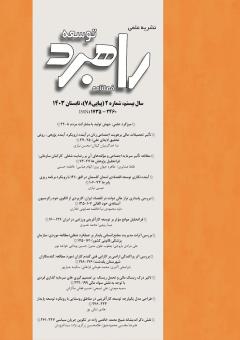آینده¬نگاری توسعه اقتصادی استان گلستان در افق 1410 با رویکرد برنامه¬ریزی پابرجا
محورهای موضوعی :
1 - استادیار؛ گروه مدیریت، دانشکده علوم انسانی و اجتماعی، دانشگاه گلستان، گرگان؛ ایران
کلید واژه: کلیدواژه: آينده¬نگاري, توسعه اقتصادی, برنامه¬ريزي پابرجا, استان گلستان,
چکیده مقاله :
این تحقیق به منظور آينده¬نگاري توسعه اقتصادي استان گلستان در افق 1410 با رويكرد برنامه-ريزي پابرجا طراحی شد. شیوه انجام این تحقیق به صورت کمی بوده و ابزار تحقیق شامل دو پرسشنامه کمی و کیفی (مصاحبه عمیق) بود. جامعه آماری پژوهش نیز مشتمل بر کلیه کارکنان مربوط به بخش توسعه شهری و امور اقتصادی استانداری گلستان می¬باشند که با توجه به محدودیت اعضای جامعه آماری (7 نفر)، کلیه اعضای جامعه آماری به شیوه سرشماری مورد مصاحبه قرار گرفتند. روایی و پایایی ابزار تحقیق که از پژوهش زالی و همکاران (1394) اتخاذ شد، قبلاً توسط این گروه تائید نهایی شده بود. یافته¬های اين تحقيق حاكي از آن است که هفت سناريوي باوركردني با تركيبهاي متفاوتي از وضعيتها، احتمال وقوع در استان گلستان را دارند كه با در نظر گرفتن میانگین، احتمال وقوع رويدادهاي مثبت بيشتر از ديگر سناريوها است. با اينكه، تعداد كمتري از اين سناريوها مطلوب هستند و بخش عمده¬اي از سناريوهاي هفت¬گانه، حالت هاي نامطلوب را نشان ميدهند، ولي احتمال تحقق شرايط بحراني در استان به مراتب پايينتر از احتمال تحقق شرايط مطلوب است. تحليل شرايط حاضر استان نشان مي-دهد که استان گلستان با اهداف و آرمان¬هاي نظريه پايه توسعه فاصله زيادی دارد و راه دراز و پر فراز و نشيبي براي تحقق آن فراروي استان است. به عبارت دیگر استان گلستان در حال حاضر از شرايط خوبي برخوردار نيست و فاصله چنداني از نقطه مبدأ به سمت اهداف توسعه نگرفت¬ است. در برخي وضعيت¬ها نيز شرايط بحراني يا نامطلوب حاكم بوده است. اگرچه، روندها حاكي از توسعه تدريجي و رو به جلوي استان است، ولي اين روندها به اندازه اي بطئي و كند است كه در مقايسه با اهداف نظريه پايه و فاصله زماني طولانی تا تحقق آنها، بسيار ناچيز بوده و به نظر ميرسد تغيير و تحول گستردهاي براي معماري آينده طلب ميكند.
Eesa Niazi Abstract This research was designed to study and identify vulnerable economic development strategies with the ABP in Golestan Province. The method of doing this research was quantitative and the research tools included two quantitative and qualitative questionnaires (in-depth interviews). The statistical population of the study consisted of all employees of the Department of Urban Development and Economic Affairs of the Golestan Governorate, consisting of 7 people. Validity and reliability of the research tool, adopted by Zali et al. (1394), were finalized by this group. The findings of this research indicate that seven believable scenarios with different combinations of situations are likely to occur in Golestan province, and considering the average, the probability of positive events is higher than other scenarios. Although fewer of these scenarios are favorable and most of the seven scenarios show unfavorable situations, the probability of the realization of critical conditions in the province is far lower than the probability of the realization of favorable conditions. The analysis of the current conditions of the province shows that Golestan province is far from the goals and ideals of the basic theory of development, and there is a long and ups and down road ahead of the province to realize it. In other words, Golestan province currently does not have good conditions and has not moved far from the starting point towards development goals. In some situations, critical or unfavorable conditions prevailed. Although, the trends indicate the gradual and forward development of the province, but these trends are so slow and slow that compared to the goals of the basic theory and the long period of time until their realization, it is very insignificant and it seems that the change and It requires extensive transformation for future architecture.
